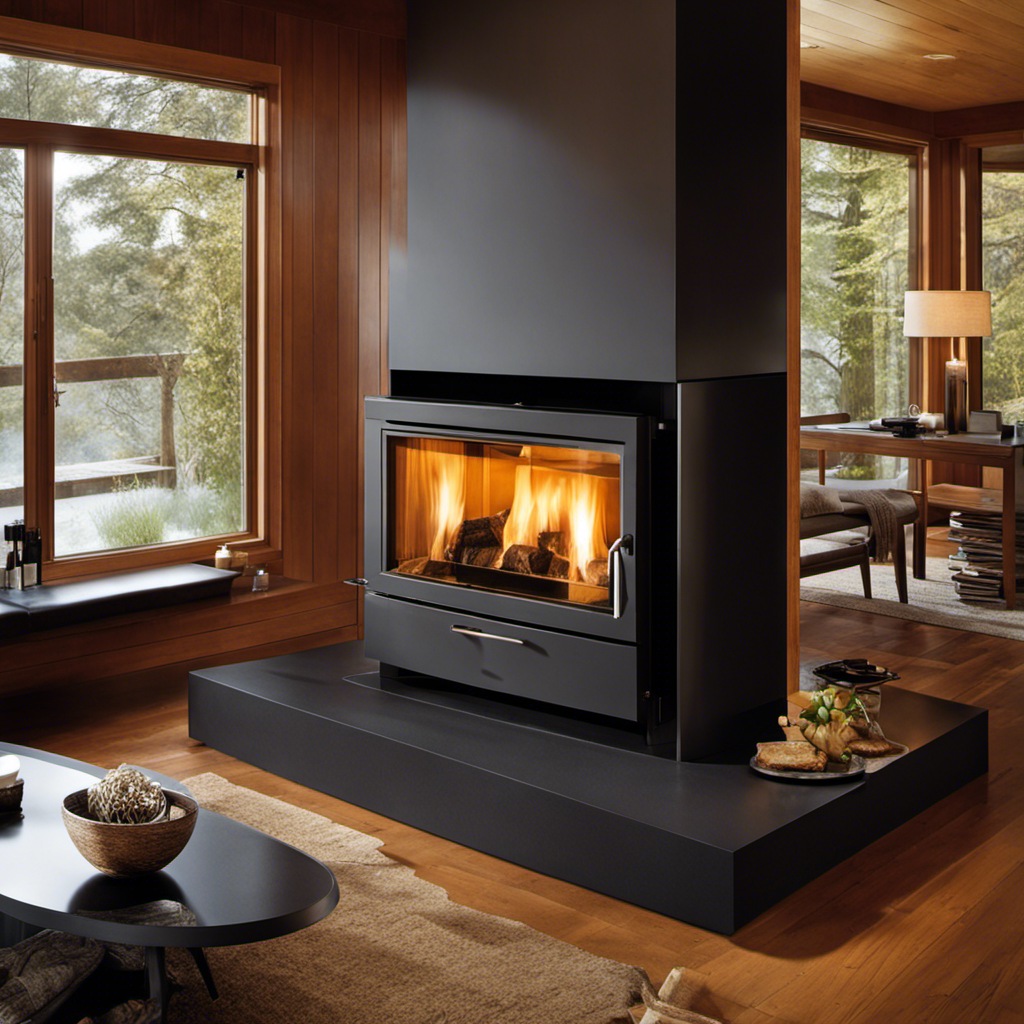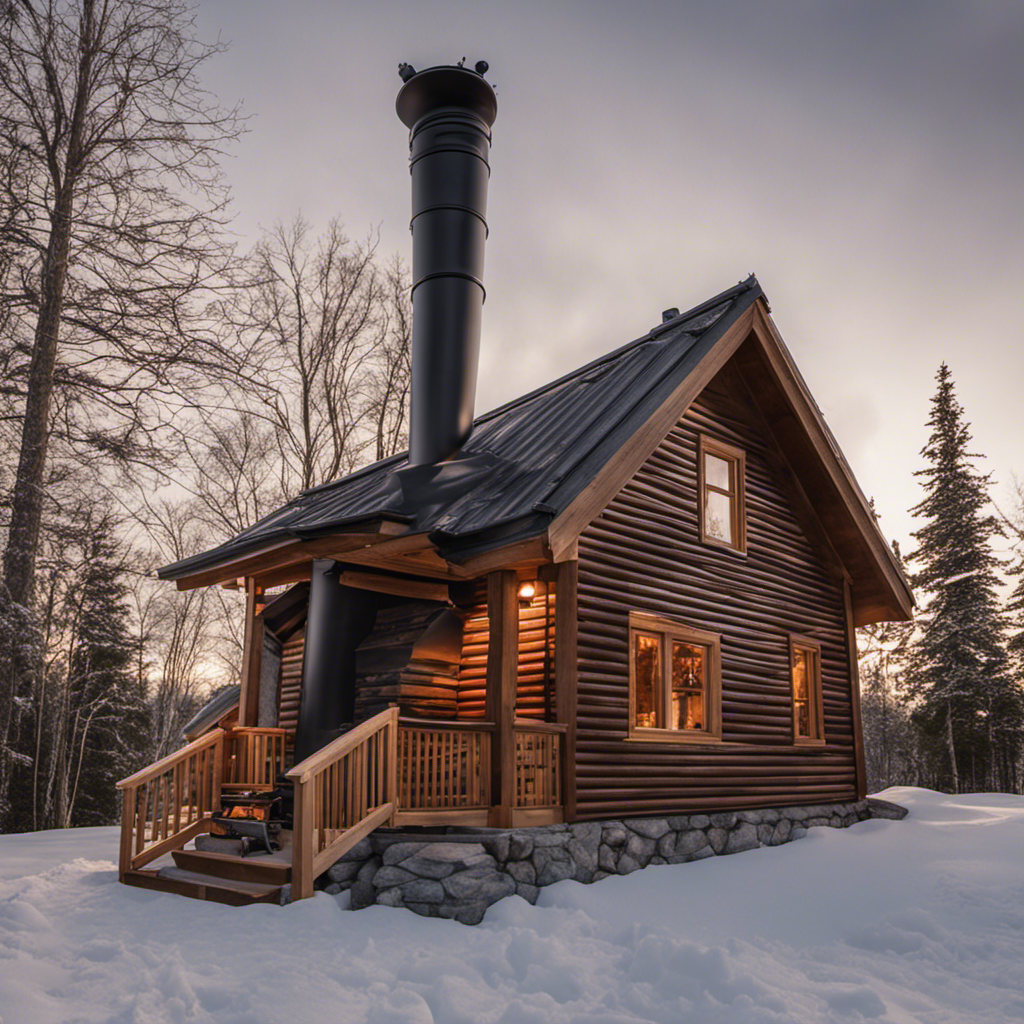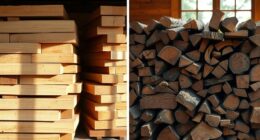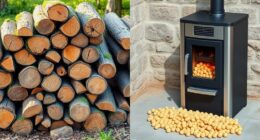As an individual who truly values wood-burning stoves, I understand the importance of maintaining their cleanliness for safety and efficiency reasons.
Like a well-tuned instrument, regular cleaning ensures your wood stove performs at its best. But how often should I clean it?
In this article, I will guide you through the factors that determine cleaning frequency, provide a recommended cleaning schedule, and share signs that indicate your wood stove needs attention.
Get ready to learn how to properly care for your beloved wood stove.
Key Takeaways
- Regular cleaning is important to ensure optimal performance and efficiency of a wood stove.
- The frequency of cleaning depends on factors such as burning frequency and duration, as well as the type of wood used.
- Hardwoods like oak, maple, and hickory produce less creosote buildup and require less frequent cleaning.
- Signs that a wood stove needs cleaning include strong odors, excessive smoke, slow or inefficient burning, and visible soot buildup.
The Importance of Regular Wood Stove Cleaning
I understand the importance of regular wood stove cleaning to maintain its efficiency and prevent potential hazards. As someone who’s been using a wood stove for many years, I’ve come to appreciate the benefits of regular maintenance. While it may seem like a tedious task, professional cleaning is essential for ensuring the longevity and optimal performance of your wood stove.
One of the main reasons why professional cleaning is important is because it helps to remove any buildup of creosote. Creosote is a highly flammable substance that can accumulate in the chimney and stovepipe over time. If left unattended, it can lead to chimney fires, which can be extremely dangerous and damaging. By having your wood stove professionally cleaned on a regular basis, you can significantly reduce the risk of a chimney fire occurring.
Another benefit of regular maintenance is that it helps to improve the efficiency of your wood stove. Over time, soot and ash can build up inside the stove, affecting its ability to generate heat. By having your wood stove cleaned regularly, you can ensure that it operates at its full potential, providing you with a consistent and efficient source of heat.
Factors That Determine Cleaning Frequency
When it comes to determining the frequency of cleaning your wood stove, there are a few key factors to consider.
Firstly, the burning frequency and duration play a significant role. The more often and longer you use your wood stove, the more frequently it will need to be cleaned.
Secondly, the type of wood used also affects cleaning frequency, as certain woods produce more creosote and residue than others.
Taking these factors into account will help ensure that your wood stove is cleaned regularly and operating efficiently.
Burning Frequency and Duration
The frequency and duration of burning in my wood stove greatly affects its overall cleanliness. Burning efficiency plays a crucial role in determining how often I need to clean my wood stove. When the wood burns efficiently, it produces less smoke and soot, resulting in a cleaner stove.
On the other hand, if the burning efficiency is low, more smoke and soot will be generated, leading to a dirtier stove. This isn’t only an aesthetic concern but also has a significant impact on air quality. A dirty wood stove emits more pollutants into the air, contributing to poor indoor and outdoor air quality.
Therefore, it’s essential to ensure that the burning efficiency is maximized to maintain a clean wood stove and promote better air quality.
Type of Wood Used
Using hardwoods instead of softwoods in my wood stove results in a longer burn time and more efficient heat output.
Hardwoods, such as oak, maple, and hickory, are denser and have a higher energy content than softwoods like pine or fir. This means that they burn slower and produce more heat for a longer period of time.
When it comes to wood stove maintenance, using hardwoods can also help reduce the amount of creosote buildup in the chimney, as they produce less smoke and release fewer volatile compounds.
Additionally, hardwoods tend to produce less ash and require less frequent cleaning compared to softwoods.
Overall, choosing the right type of wood for your wood stove can greatly impact its performance and maintenance requirements.
Recommended Cleaning Schedule for Wood Stoves
To keep your wood stove in optimal condition and ensure its efficient performance, it’s important to follow a recommended cleaning schedule. Regular cleaning helps to prevent the build-up of creosote, ash, and other debris that can affect your stove’s functionality and pose potential safety hazards.
In the following points, I’ll discuss the frequency of cleaning and the methods and tools you can use to effectively maintain your wood stove.
Frequency of Cleaning
I should clean my wood stove every few months to ensure proper functionality. Regular cleaning not only helps to maintain the burning efficiency of the stove but also ensures the safety of your home.
Here are some important reasons why cleaning your wood stove is crucial:
-
Prevents creosote buildup: Creosote is a byproduct of burning wood that can accumulate on the interior walls of the stove and chimney. Regular cleaning helps to remove this flammable substance, reducing the risk of chimney fires.
-
Improves air quality: A clean wood stove burns more efficiently, producing less smoke and reducing the emission of harmful pollutants into the atmosphere.
-
Extends the lifespan of the stove: Regular cleaning and maintenance can prevent damage and prolong the life of your wood stove, saving you money in the long run.
Cleaning Methods and Tools
Regular maintenance and proper cleaning tools are essential for keeping my wood stove in good condition. When it comes to cleaning my wood stove, I’ve found that using the right techniques and supplies is crucial.
To start, I always make sure to remove any ashes and debris from the stove before proceeding with the cleaning process. For this, I use a metal scoop and a sturdy brush to carefully sweep away the ashes.
Next, I use a damp cloth or sponge to clean the exterior of the stove, making sure to remove any dirt or stains. When it comes to the interior, I use a specialized stove cleaner and a scrub brush to remove any built-up creosote or soot.
By following these cleaning techniques and using the appropriate supplies, I can ensure that my wood stove remains in optimal condition.
Now, let’s move on to the signs that indicate when my wood stove needs cleaning.
Signs That Your Wood Stove Needs Cleaning
When my wood stove starts emitting a strong and unpleasant odor, I know it’s time for a cleaning. Regular maintenance of your wood stove is crucial to ensure its efficiency and safety. Here are the signs that indicate your wood stove needs cleaning:
-
Excessive smoke: If you notice an increase in smoke production while using your wood stove, it may be a sign of creosote buildup inside the chimney or flue. This not only affects the stove’s performance but also poses a fire hazard.
-
Slow or inefficient burning: If your wood stove isn’t burning wood as efficiently as it used to, it could be due to a clogged airway or a dirty combustion chamber. This can lead to decreased heat output and wasted fuel.
-
Soot accumulation: A visible layer of black soot on the interior surfaces of your wood stove is a clear indication that it needs cleaning. Soot buildup can hinder proper airflow and cause poor combustion.
Regularly cleaning your wood stove is of utmost importance to ensure its optimal performance and prevent potential hazards. Now, let’s move on to the steps to properly clean your wood stove.
Steps to Properly Clean Your Wood Stove
To properly clean your wood stove, it’s important to follow these steps.
Cleaning frequency plays a crucial role in maintaining the efficiency and safety of your wood stove. I recommend cleaning your wood stove at least once a year, preferably before the start of the heating season. However, if you use your wood stove frequently, it may require more frequent cleaning.
Proper maintenance not only ensures optimal performance but also extends the lifespan of your wood stove.
Start by allowing the stove to cool completely before beginning the cleaning process. Remove any ashes and debris from the firebox using a shovel or brush.
Next, clean the stove’s glass door using a non-abrasive cleaner specifically designed for wood stoves. Wipe away any soot and grime, ensuring a clear view of the fire.
Inspect the stove’s gaskets and replace any that are worn or damaged. These gaskets help create an airtight seal, improving the stove’s efficiency.
Check the chimney and flue for creosote buildup and remove it using a chimney brush or hire a professional chimney sweep for a thorough cleaning.
Finally, vacuum the exterior of the stove to remove any dust and dirt. Pay attention to the stove’s vents and air intake, ensuring they’re clear of obstructions.
Common Mistakes to Avoid During Wood Stove Cleaning
When it comes to cleaning your wood stove, there are some common mistakes that you should avoid to ensure a safe and effective cleaning process. Here are some cleaning tips to help you avoid these common mistakes:
-
Neglecting regular cleaning: One of the biggest mistakes isn’t cleaning your wood stove regularly. It’s important to clean it at least once a year to prevent the buildup of creosote and other debris. Regular cleaning will also improve the efficiency and safety of your wood stove.
-
Using the wrong cleaning products: Another common mistake is using the wrong cleaning products. Avoid using harsh chemicals or abrasive materials that can damage the surface of your wood stove. Instead, opt for mild soapy water and a soft cloth or brush to gently clean the stove.
-
Not properly disposing of ash: Many people make the mistake of not disposing of ash properly. Always wait for the ash to cool down completely before removing it from the stove. Use a metal container with a tight-fitting lid to store the ash, and dispose of it in a designated area away from flammable materials.
Maintenance Tips to Extend the Lifespan of Your Wood Stove
I find it helpful to regularly inspect and maintain my wood stove to ensure it lasts longer. Proper maintenance not only extends the lifespan of the stove but also ensures its safe and efficient operation. To help you keep your wood stove in top shape, here is a maintenance checklist to follow.
Firstly, make sure to clean the stove regularly. Remove any ashes and debris from the firebox, as well as the baffle and flue pipes. This helps to prevent blockages and improve airflow. Additionally, clean the glass door using a non-abrasive cleaner to maintain visibility.
Next, check the gaskets and seals for any signs of wear or damage. Replace them if necessary to maintain an airtight seal. Inspect the fire bricks and replace any that are cracked or broken to ensure proper insulation.
Additionally, it’s important to schedule a professional chimney sweep at least once a year to remove creosote buildup and ensure proper ventilation. This not only improves the stove’s efficiency but also reduces the risk of chimney fires.
Lastly, always follow cleaning safety precautions. Wear gloves and protective eyewear when handling ashes or cleaning the stove. Ensure the stove is completely cool before starting any maintenance tasks.
Frequently Asked Questions
Can I Use Regular Household Cleaning Products to Clean My Wood Stove?
Yes, you can use regular household cleaning products to clean your wood stove. However, it’s important to choose the right products that are safe and effective for cleaning wood stoves. Avoid using abrasive cleaners or anything that can scratch the surface. Instead, opt for gentle cleaners specifically designed for wood stoves.
It’s also recommended to follow the manufacturer’s instructions for cleaning methods and products to ensure the longevity and efficiency of your wood stove.
Is It Necessary to Clean the Chimney as Well When Cleaning the Wood Stove?
When it comes to cleaning my wood stove, I always make sure to give it a thorough cleaning.
But what about the chimney? Well, let me tell you, it’s absolutely necessary to clean the chimney when cleaning the wood stove.
Proper chimney maintenance is crucial for the safe and efficient operation of your stove.
There are various chimney cleaning tools and methods available to help you keep your chimney clean and free from any blockages or buildup.
How Often Should I Clean the Glass Door of My Wood Stove?
Cleaning frequency for the glass door of a wood stove depends on several factors such as usage and buildup of soot. It’s recommended to clean the glass door regularly to maintain its transparency and ensure efficient heat transfer.
The best cleaning method involves using a non-abrasive glass cleaner or a mixture of vinegar and water. Regularly inspect the glass door for any signs of dirt or residue and clean as needed to keep it looking clean and functioning properly.
Can I Burn Wet or Unseasoned Wood in My Wood Stove Without Affecting Its Cleanliness?
Burning wet or unseasoned wood in a wood stove can definitely impact its cleanliness. When wood has a high moisture content, it produces more smoke, which can lead to the buildup of creosote and soot on the interior surfaces of the stove.
This buildup can reduce the stove’s efficiency and increase the risk of a chimney fire. Therefore, it’s important to only burn properly seasoned wood in your wood stove to maintain its cleanliness and safety.
Is It Safe to Clean My Wood Stove While It Is Still Hot?
It’s important to prioritize safety when it comes to wood stove maintenance.
Cleaning your wood stove while it’s still hot can be dangerous and should be avoided. Wait for it to cool down before starting the cleaning process.
Regular cleaning is essential to keep your wood stove functioning efficiently and prevent the buildup of creosote, a flammable substance that can lead to chimney fires.
Follow proper cleaning tips and guidelines to ensure your wood stove stays in optimal condition.
Conclusion
In conclusion, regularly cleaning your wood stove is essential for its longevity and efficiency. By following a recommended cleaning schedule and being aware of signs that your stove needs cleaning, you can ensure that it operates at its best.
Taking the time to clean your stove properly and avoiding common mistakes will also contribute to its lifespan. So, don’t neglect your wood stove – give it the care it deserves and it will reward you with warmth and comfort for years to come.
Logan’s affair with adventure began in childhood. He hailed from a small town where vast forests bordered one side and endless shores stretched on the other. His days were spent exploring uncharted woods, climbing tall trees, or listening to the tales of old sailors. This early immersion in a world brimming with stories and mysteries became the foundation of his passion for writing.











